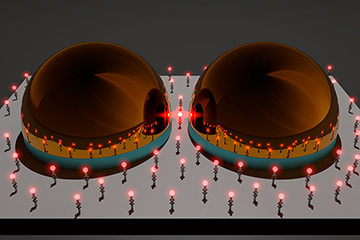 The signal from a quantum emitter, used as a sensing label for an antibody–antigen complex, is enhanced via placement in a plasmonic nanocavity. [Enlarge figure]
The signal from a quantum emitter, used as a sensing label for an antibody–antigen complex, is enhanced via placement in a plasmonic nanocavity. [Enlarge figure]
Plasmonic nanostructures facilitate strong light–matter interaction by squeezing light into a nanoscale volume, far below the light’s wavelength. This unique property of surface plasmons has sparked a wide range of applications, including nano-lasing, solar cells and cancer treatment. A 2016 experiment first demonstrated single-emitter strong light–matter coupling at room temperature by placing a quantum emitter inside a plasmonic nanocavity, formed at a 1-nm gap between two metal surfaces.1 This year, we used this concept of room-temperature, single-emitter strong coupling to propose an innovative protocol for quantum plasmonic immunoassay sensing.2
Intense efforts have been undertaken to enhance the sensitivity of immunoassays—biochemical tests that measure the presence of specific molecules (antigens) in a solution using antibodies. Detecting antigens directly using light, however, is an extremely inefficient process, due to the size mismatch between typical antigens, which are less than 100 nm in size, and visible-light wavelengths in the 400-to-700-nm range.
Most immunoassays, therefore, chemically link optically active labels with antibodies. Embedding the immunoassay on plasmonic structures, which are capable of compressing light into a volume comparable in size to the labels, can massively enhance this signal. For example, fluorophores have been used as labels in a plasmonic immunoassay designed to detect prostate-specific antigens, with the plasmonic structure boosting the fluorescence emission.3 Yet studies on immunoassays thus far have not yet explored the strong light–matter-coupling regime.
In the proposed immunoassay protocol, a quantum emitter is employed as a sensing label for an antibody−antigen−antibody complex, which is then placed inside a plasmonic hemisphere-dimer nanocavity. The nanocavity facilitates strong light–matter interaction with the emitter label, and ultra-sensitivity is achieved via the characteristic signature of Rabi splitting, which is equivalent to a bidirectional spectral shift.
We demonstrated that the proposed immunoassay is 15 times more sensitive than conventional shifting-type sensors. Through statistical studies using randomly distributed emitter-labeled complexes, the proposed protocol also maintained a stable concentration-independent sensing sensitivity down to the single-analyte quantum-sensing limit. Our results show potential for future experiments based on our quantum plasmonic immunoassay sensing to reach the single-antigen detection limit.
The current protocol involves a quantum phenomenon (strong coupling with a quantum emitter) to detect a classical object (antigen). Moving forward, this approach can be potentially applied to quantum objects, such as electronic spins in nanodiamonds,4 and allows for the possibility of room-temperature quantum sensing.
Researchers
Nuttawut Kongsuwan and Ortwin Hess, Imperial College London, London, U.K.
Xiao Xiong, Ping Bai, Jiabin You, Ching Eng Png and Lin Wu, Institute of High Performance Computing, Singapore
References
1. R. Chikkaraddy et al. Nature 535, 7610 (2016).
2. N. Kongsuwan et al. Nano Lett. 19, 5853 (2019).
3. Q. Zhang et al. Intl. J. Nanomed. 12, 2307 (2017).
4. M. Doherty et al. Phys. Rep. 528, 1 (2013).

